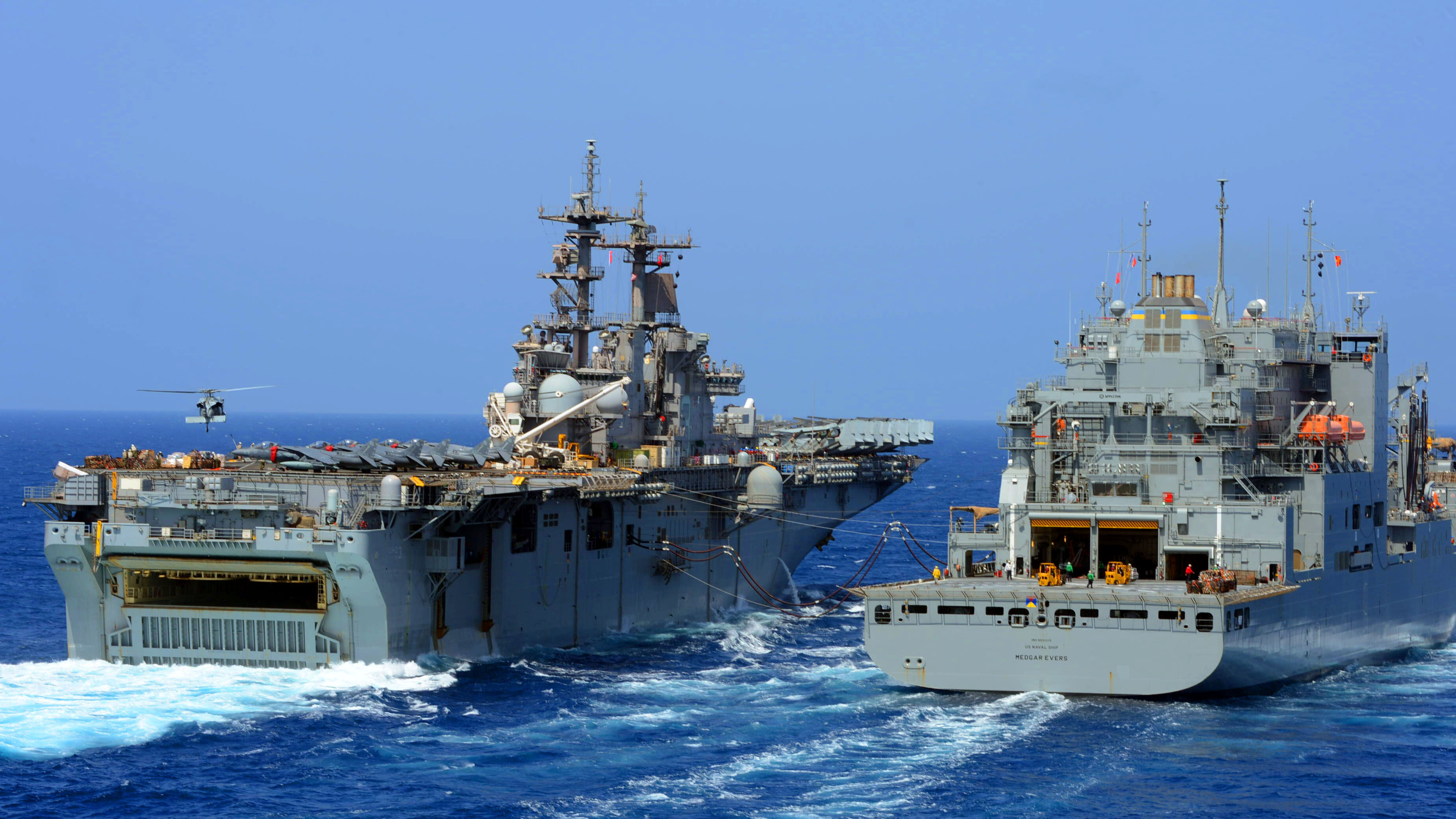
The supply ship USNS Medgar Evers (T-AKE 13, right)) replenishes the amphibious ship USS Kearsage (LHD 3, left). (Photo by US Navy.)
WASHINGTON: Lawmakers from the House and Senate and across the political aisle for several years now have yelled at the Navy to stop dragging its feet on recapitalizing its surge sealift fleet. Now, the Navy says a proposed Senate cut in the upcoming defense spending bill would effectively sink its plans from the start.
In its version of the bill, the Senate Appropriations Committee cuts roughly $300 million that the Maritime Administration (MARAD) planned to use to buy used sealift vessels, a plan the Navy supports, but with money lawmakers say is “early to need.” The transactions are part of MARAD and the service’s larger three-pronged strategy to revitalize its surge sealift fleet, a group of auxiliary ships designed to transport Army and Marine Corps ground supplies in the event of a large-scale war.
“By removing all requested procurement funding in FY22, this vital program is effectively terminated and the ability to strategically project power by delivering the Army and Marine Corps equipment is degraded as a powerful national defense tool,” reads a Navy document obtained by Breaking Defense that outlines the Navy’s many objections to lawmakers’ proposed cuts in the fiscal 2022 defense spending bill.
“Additionally, this reduction puts at risk the government’s ‘used-buy’ market plans in future years by removing all ships that the Navy planned to buy in FY22,” the document continues.
Former Navy Secretary Richard Spencer proposed the plan to revitalize the sealift fleet to Congress in 2018, and since then lawmakers have sent a relatively unified response: This needs to get done faster. But in successive defense policy bills, lawmakers from the House and Senate armed services committees have fought over a variety of different policy mandates to force the service into paying more attention — and devoting more funding — to the less flashy, oft-overlooked fleet.
How many used vessels should be bought, how quickly they should be purchased, and who should foot the bill has been an ongoing struggle between the Pentagon, MARAD and multiple congressional factions for several years, but there has been an overwhelming consensus that the sealift fleet’s imminent restoration is necessary. In addition to buying used ships, the strategy also calls for life extensions on current vessels and new construction of a specially-designed multimission ship.
Army Gen. Stephen Lyons, the former commander of US Transportation Command, pegged sealift recapitalization as a top priority and would often publicly mention he was in the middle of discussions to accelerate the acquisitions.
The $300 million on the chopping block would go to buy used ships in FY22 to join the first two purchases by MARAD, which were already delayed by a contract dispute. Those ships are now “expected to complete MARAD procurement actions in [January 2022] and be part of the Ready Reserve Force once contracting is complete,” according to the Navy document. The “Ready Reserve Force” is the name given to some of the auxiliary vessels managed by MARAD while in not use by the Pentagon.
The delay was caused by a bid protest sustained by the Government Accountability Office. GAO bid protests are one way industry can challenge a government contract award if a company believes the competition was unfair or conducted inappropriately. The other option is to bring the government to court. From industry’s perspective, a bid protest garners much less attention from national media and competitors compared to filing a lawsuit. The downside is that GAO’s rulings are not legally binding like that of a federal court. The only mechanism to force a government agency to act following a bid protest ruling is oversight by lawmakers, who in general respect GAO as an impartial referee.
The existence of a protest alone can delay a program from beginning work, and if a protest is sustained — most are rejected — then it could force a government agency back to square one of an acquisition depending on what GAO concluded.
In this case, MARAD awarded a contract to Crowley Government Services to manage the government’s projected purchases of used sealift vessels. Pasha Hawaii Holdings protested the award, and GAO sustained the protest in Nov. 2020.
Pasha’s allegations centered around MARAD’s assessment of Crowley’s projected pricing being “unreasonable” as well as the solicitation’s “latent ambiguity about the crew requirements.” In response, GAO recommended MARAD revise its solicitation and reimburse Pasha for costs associated with the protest.
MARAD again awarded the vessel acquisition management contract to Crowley in July 2021.
Norway’s top officer on his ‘biggest challenge,’ next frigate and new NATO neighbors
Gen. Eirik Kristoffersen, Norway’s Chief of Defense, talks to Breaking Defense about his plans for spending on new frigates and subs, the challenges of upgrading Norway’s “digital backbone” and refilling the military’s stocks.


























